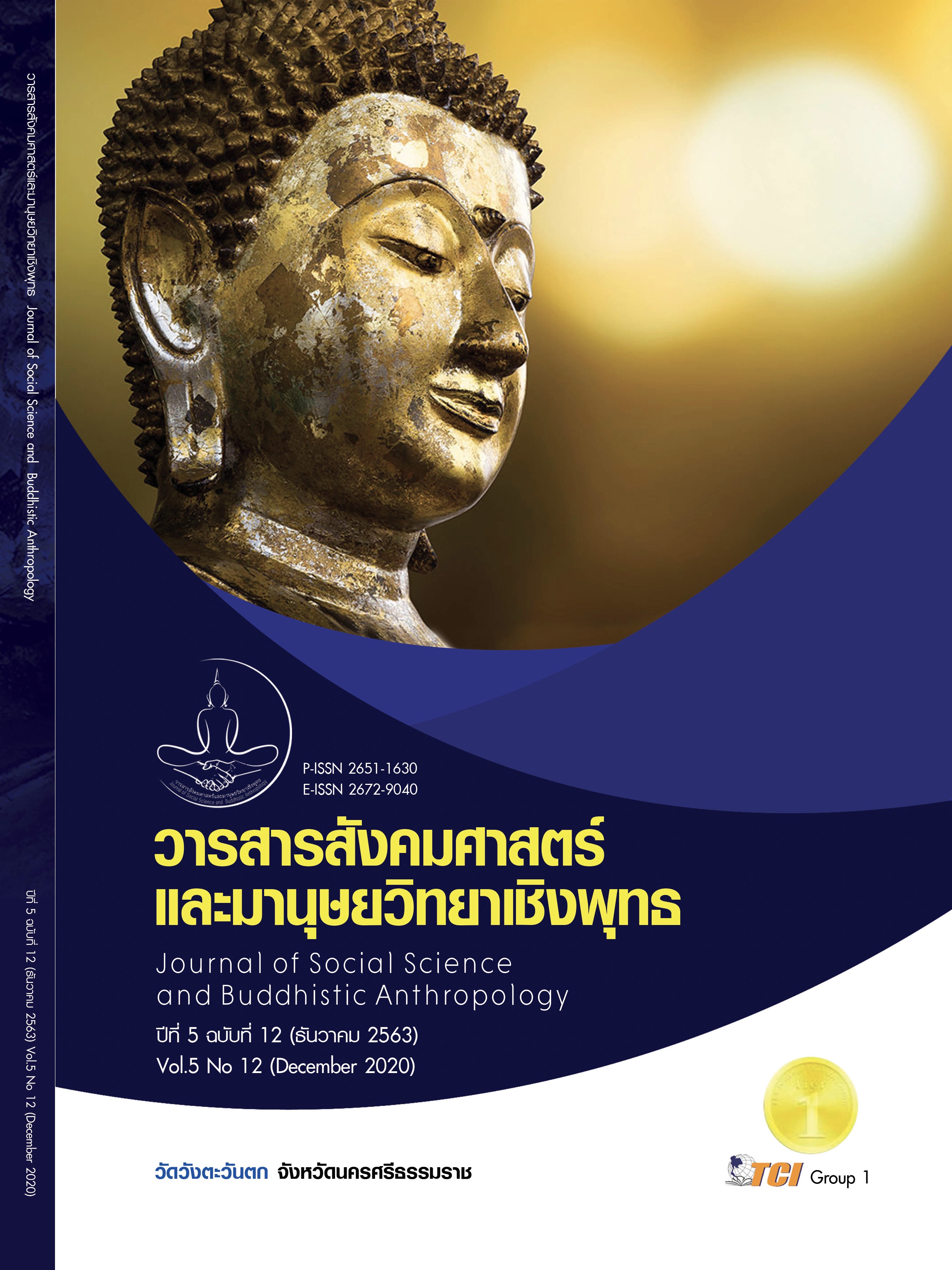THE CREATING OF HAPPINESS WITH VOLUNTEER SPIRIT ACCORDING TO BUDDHISM
Keywords:
Happiness, Volunteer Spirit, Ban Pa - O Community, BuddhismAbstract
The purposes of this article were 1) to study the process of happiness by volunteer spirit according to Buddhism, 2) to develop the process of creating happiness by volunteer spirit in Ban Pa - O community, Singhanakhon District, Songkhla Province and 3) to analyze the creation of happiness by volunteer spirit according to Buddhism. This research was a qualitative research focus on document and field study. The research instrument was in - depth interview. The sample consisted of 20 persons. The presentation was by the analytical description. The results of the research were found as follows: The process of creating happiness by volunteer spirit in accordance with Buddhism. This is due to the influence of Buddhist doctrines that focus on the human mind, be generous and selfless is someone who aims to benefit others Is a very hospitable person, pure heart. The doctrines related to creating happiness through volunteerism are: Sanggahavatthu 4, Iddhipadha 4, Garavasadhamma 4, Saranyyadhamma 6 and Brahma Vihara 4 as a guideline of practice. The development of the process of creating happiness with voluntary spirit of Ban Pa-O community, Singhanakhon District, Songkhla Province, whereby Ban Pa-O community people have behaviors that are ready to sacrifice for the public. Both physical and mental strength, be generous, kindness, diligence, patience, honesty Enthusiasm for helping others There were adults in the community as an example to follow in various areas, including helping others. The sacrifice to society and development commitment when analyzing the creation of happiness by volunteering according to Buddhism, it was found that the practice of volunteering with pure mind. Helping others without expecting rewards, make sacrifices for society and strive to improve the quality of life for everyone to achieve peace and tranquility.
References
ไจตนย์ ศรีวังพล. (2552). ศึกษาการประยุกต์หลักพุทธธรรมในการทางานจิตอาสาของอาสาสมัคร สวพ. 91. ใน วิทยานิพนธ์พุทธศาสตรมหาบัณฑิต สาขาวิชาพุทธศาสตร์และศิลปะแห่งชีวิต. มหาจุฬาลงกรณราชวิทยาลัย.
ดวงทิพย์ อันประสิทธิ์. (2555). รูปแบบการขัดเกลาทางสังคมเพื่อเสริมสร้างจิตอาสาในชุมชน: กรณีศึกษาชุมชนบางน้ำหวาน อำเภอพระประแดง จังหวัดสมุทรปราการ. ใน วิทยานิพนธ์ศิลปศาสตรมหาบัณฑิต สาขาวิชาการบริหารการพัฒนาสังคม. สถาบันบัณฑิตพัฒนบริหารศาสตร์.
ทศพล ดำแดง. (2553). การรับรู้ชีวิตและความตายกับความงอกงามทางจิตใจ กรณีศึกษาอาสาสมัครธรรมรักษ์นิเวศน์ วัดพระบาทน้ำพุ จังหวัดลพบุรี. ใน วิทยานิพนธ์พุทธศาสตรมหาบัณฑิต สาขาวิชาชีวิตและความตาย. มหาวิทยาลัยมหาจุฬาลงกรณราชวิทยาลัย.
ทิพย์ขจร ฉายาสกุลวิวัฒน์. (2556). ศึกษากระบวนการจิตอาสาตามหลักพระพุทธศาสนาของเจ้าหน้าที่เสถียรธรรมสถาน. ใน วิทยานิพนธ์พุทธศาสตรมหาบัณฑิต สาขาวิชาพุทธศาสตร์และศิลปะแห่งชีวิต. มหาจุฬาลงกรณราชวิทยาลัย.
พระพรหมมังคลาจารย์ (ปัญญานันทภิกขุ). (2550). รักลูกให้ถูกทาง. กรุงเทพมหานคร: โรงพิมพ์พระพุทธศาสนาของธรรมสภา.
มิชิตา จำปาเทศ รอดสุทธิ. (2561). จิตออาสาพัฒนาผู้นำ. เรียกใช้เมื่อ 4 เมษายน 2561 จาก http://www.vachiraphuket.go.th/www/volunteer/?name=knowledge&file=readknowledge&id=1
ศุภรัตน์ รัตนมุขย์. (2548). อาสาสมัคร: การพัฒนาคนเองและสังคม. วารสารพัฒนศาสตร์, 1(2), 1-9.
สถาบันธุรกิจเพื่อสังคม. (2552). เข็มทิศธุรกิจเพื่อสังคม. กรุงเทพมหานคร: โรงพิมพ์ไอคอน พริ้นติ้ง.
สมโภชน์ เอี่ยมสุภาษิต. (2526). การปรับพฤติกรรม. กรุงเทพมหานคร: โอเดียนสโตร์.
สำนักงานพัฒนาเศรษฐกิจและสังคมแห่งชาติ. (2553). กรอบทิศทางการจัดสวัสดิการทางสังคมที่ยั่งยืน ในช่วงแผนฯ 11. กรุงเทพมหานคร: โรงพิมพ์ไอคอน พริ้นติ้ง.








